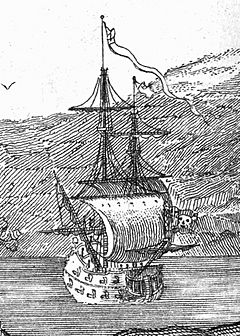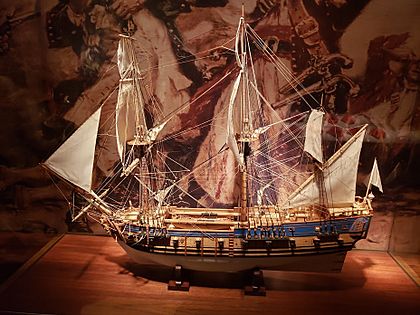Queen Anne's Revenge facts for kids

Illustration published in 1736
|
|
Quick facts for kids History |
|
|---|---|
| Name | La Concorde |
| Launched | c. 1710 |
| Captured | Saint Vincent, 28 November 1717 |
| Name | Queen Anne's Revenge |
| Fate | Ran aground on 10 June 1718 near Beaufort Inlet, North Carolina |
| General characteristics | |
| Class and type | Frigate |
| Tons burthen | 200 bm |
| Length | 103 ft (31.4 m) |
| Beam | 24.6 ft (7.5 m) |
| Sail plan | Full-rigged |
| Complement | up to 300 in Blackbeard's service |
| Armament | 40 cannons (alleged), 30 found |
|
Queen Anne's Revenge
|
|
| Lua error in Module:Location_map at line 420: attempt to index field 'wikibase' (a nil value). | |
| Nearest city | Atlantic Beach, North Carolina |
| Area | less than one acre |
| Built | c. 1710 |
| NRHP reference No. | 04000148 |
| Added to NRHP | March 9, 2004 |
Queen Anne's Revenge was an early-18th-century ship, most famously used as a flagship by Edward Teach, better known by his nickname Blackbeard. Although the date and place of the ship's construction are uncertain, it was originally believed she was built for merchant service in Bristol, England in 1710 and named Concord, later captured by French privateers and renamed La Concorde. After several years' service by French sailors (both as a naval frigate and as a merchant vessel – much of the time as a slave trading ship), she was captured by Blackbeard in 1717. Blackbeard used the ship for less than a year, but captured numerous prizes using her as his flagship.
In May 1718, Blackbeard ran the ship aground at Topsail Inlet, now known as Beaufort Inlet, North Carolina, United States, in the present-day Carteret County. After the grounding, her crew and supplies were transferred to smaller ships. In 1996, Intersal Inc., a private firm, discovered the remains of a vessel that was later determined to be Queen Anne's Revenge, which was added to the U.S. National Register of Historic Places. The shipwreck was discovered off Beaufort Inlet, North Carolina
History
The ship that would be known as Queen Anne's Revenge was a 200-ton vessel believed to have been built in 1710. She was handed over to René Duguay-Trouin and employed in his service for some time before being converted into a slave ship, then operated by the leading slave trader René Montaudin of Nantes, until sold in 1713 in Peru or Chile. She was briefly re-acquired by the French Navy in November 1716, but was sold by them for commerce five months later in France, again for use as a slaver. She was captured by Blackbeard and his pirates on 28 November 1717, near the island of Saint Vincent in the West Indies.
After selling her cargo of slaves at Martinique, Blackbeard made the vessel into his flagship, adding more heavy cannon and renaming her Queen Anne's Revenge. The name may come from the War of the Spanish Succession, known in the Americas as Queen Anne's War, in which Blackbeard had served in the Royal Navy, or possibly from sympathy for the Jacobite cause (Queen Anne being the last Stuart monarch). Blackbeard sailed this ship from the west coast of Africa to the Caribbean, attacking British, Dutch, and Portuguese merchant ships along the way.
Shortly after blockading Charleston harbor in May 1718, and refusing to accept the Governor's offer of the King's Pardon, Blackbeard ran Queen Anne's Revenge aground while entering Beaufort Inlet, North Carolina on 10 June 1718. A deposition given by David Herriot, the former captain of the sloop Adventure, states "Thatch's [Teach's] ship Queen Anne's Revenge run a-ground off of the Bar of Topsail-Inlet." He also states that Adventure "run a-ground likewise about Gun-shot from the said Thatch" in an attempt to kedge Queen Anne's Revenge off the bar. Blackbeard then disbanded his flotilla and escaped by transferring supplies onto the smaller Adventure. He stranded several crew members on a small island nearby, where they were later rescued by Captain Stede Bonnet. Some suggest Blackbeard deliberately grounded the ship as an excuse to disperse the crew. Shortly afterward, he surrendered and accepted the King's Pardon for himself and his remaining crewmen from Governor Charles Eden at Bath, North Carolina. However, Blackbeard returned to piracy later that year and was killed in combat in November 1718.
Discovery and excavation

Intersal Inc., a private research firm, discovered the wreck believed to be Queen Anne’s Revenge on November 21, 1996. It was located by Intersal's director of operations, Mike Daniel, who used historical research provided by the company's president, Phil Masters and maritime archaeologist David Moore. The shipwreck lies in 28 feet (8.5 m) of water about one mile (1.6 km) offshore of Fort Macon State Park (34°41′44″N 76°41′20″W), Atlantic Beach, North Carolina. On 3 March 1997, the governor of North Carolina, James B. Hunt held a press conference in Raleigh, North Carolina. He stated: "The state of North Carolina is working to protect the site and will do everything we can to that end. We look forward to the day when all North Carolinians can see these exciting artifacts for themselves." Thirty cannons have been identified to date and more than 300,000 artifacts have been recovered. The cannons are of different origins including Sweden and England, and of different sizes as would be expected with a colonial pirate crew.
For one week in 2000 and 2001, live underwater video of the project was webcast to the Internet as a part of the QAR DiveLive educational program that reached thousands of children around the world. Created and co-produced by Nautilus Productions and Marine Grafics, this project enabled students to talk to scientists and learn about methods and technologies utilized by the underwater archaeology team.
In November 2006 and 2007, more artifacts were discovered at the site and brought to the surface. The additional artifacts appear to support the claim that the wreck is that of Queen Anne's Revenge. Among evidence to support this theory is that the cannons were found loaded. In addition, there were more cannons than would be expected for a ship of this size, and the cannons were of different makes. Depth markings on the part of the stern that was recovered point to it having been made according to the French foot measurements.
By the end of 2007, approximately one third of the wreck was fully excavated. Part of the hull of the ship, including much of the keel and part of the stern post, has survived. The 1,500-pound (680 kg) stern post was recovered in November 2007. The NCDNCR set up the website Queen Anne's Revenge to build on intense public interest in the finds. Artifacts recovered in 2008 include loose ceramic and pewter fragments, lead strainer fragments, a nesting weight, cannon apron, ballast stones, a sword guard and a coin.
Goals during the 2010 field season included staging of one of the ship's largest main deck cannons to the large artifact holding area on site, taking corrosion readings from anchors and cannon undergoing in situ corrosion treatment, attaching aluminum-alloy anodes to the remaining anchors and cannons so as to begin their in situ corrosion treatment and continuing site excavations.
In 2011, the 0.9-tonne (2,000 lb) anchor from the ship was brought to the surface, along with a range of makeshift weaponry including langrage or canister shot.
On August 29, 2011, the National Geographic Society reported that the State of North Carolina had confirmed the shipwreck as Queen Anne's Revenge, reversing a conclusion previously maintained because of a lack of conclusive evidence. Specific artifacts that support this conclusion include a brass coin weight bearing the bust of Queen Anne of England, cast during her reign (1702–1714); the stem of a wine glass decorated with diamonds and tiny embossed crowns, made to commemorate the 1714 coronation of Queen Anne's successor, King George I; and the remains of a French hunting sword featuring a bust that closely resembles King Louis XV, who claimed the French throne in 1715.
On June 21, 2013, the National Geographic Society reported recovery of two cannons from Queen Anne's Revenge. Several months later, on October 28, archaeologists recovered five more cannons from the wreck.
The 23rd of 30 cannons identified at the wreck site was recovered on October 24, 2014. The gun is approximately 56 inches (140 cm) long, weighs over 300 pounds (140 kg) and may be a sister to a Swedish gun that was previously recovered. Nine cannonballs, bar shot halves, an iron bolt and a grenado were also recovered during the 2014 field season.
In January 2018, sixteen fragments of paper were identified after being recovered from sludge inside a cannon. The scraps were from a copy of the book A Voyage to the South Sea, and Round the World, Perform'd in the Years 1708, 1709, 1710 and 1711 by Captain Edward Cooke, in which Cooke travels under Woodes Rogers; it is likely the pages were torn from the book and used as wadding in that cannon. A portion of the objects and artifacts found at the shipwreck have been given on long-term loan to the Smithsonian and are on display in the National Museum of American History. Additionally, some artifacts have been loaned to the Musée National de la Marine in Paris.
In total, 24 of 30 known cannon have been excavated. Of these, six cast-iron cannon bear founder's marks or proof marks indicative of a specific nation of origin. One 1/2-pounder carries an English proof mark, a 4-pounder carries an English proof mark and the founder's mark for Major John Fuller (1652-1722) of the Heathfield Furnace in East Sussex, and four 1-pounders carry founder's markings for Jesper Eliaeson Ehrencreutz at Ehrendals works in Södermanland, Sweden. Two of the Ehrendal cannon also carry legible date marks for 1713.
National Register of Historic Places
Queen Anne's Revenge was added to the National Register of Historic Places in 2004. The reference number is 04000148. It is listed as owned by the State of North Carolina and located South of Beaufort Inlet, N.C. The wreck site is designated 31CR314 by the state of North Carolina.
See also
 In Spanish: Venganza de la Reina Ana para niños
In Spanish: Venganza de la Reina Ana para niños
- Robert Lane (pirate), whose ship was also named Queen Anne's Revenge

